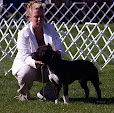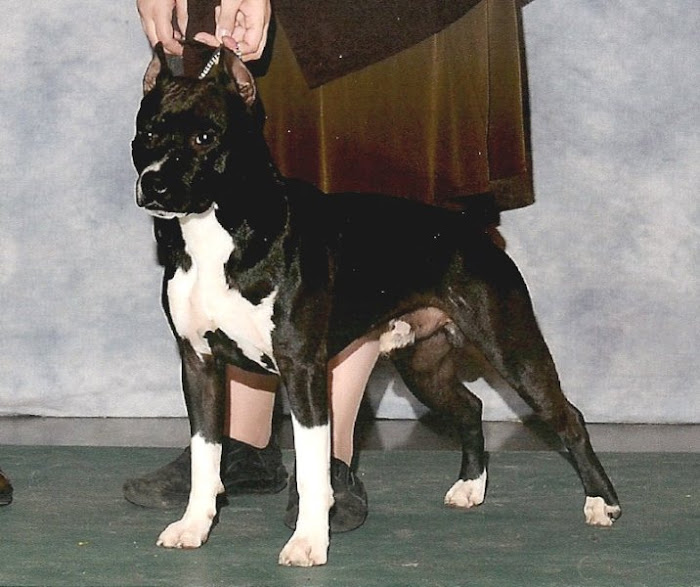Nuisance barking is never okay. I don't care what kind of dog you have - whether they are "known" barkers or not. In this day and age, in our society - where people live on top of one another - this type of behavior is NEVER alright (incessant barking means many things for your dog, boredom is more than likely one of them). Part of responsible dog ownership is controlling your dogs and tending to their needs. Barking for no reason is just as bad of a habit as peeing in your favorite shoes in my humble opinion. There is a reason that I bring this up of course...
My backyard is approximately a quarter of an acre. I have FIVE neighbor's yards that "connect" to my fence, even if only for a few feet. This can be a problem of sorts. It shouldn't have to be. The breakdown is as follows (breeds excluded): 1) the east side of my fence is occupied by 2 very small dogs; 2) part of the south fence is occupied by a large chained dog and, on occasion, their medium-sized house dog; 3) the main part of the south fence is occupied by 4+ large and unruly dogs; 4) the last small portion of the south fence now owns no dogs; and 5) the west fence is occupied by 2 medium-sized hunting dogs and 1 smallish lap dog.
The neighbors to the east, in their infinite wisdom, decided to give their small dogs a doggy door so they could pee outside while they were at work (instead of on their floor). Well, the dogs decided to go and pick fights and squeeze through tiny holes in the fence, in great attempts at becoming lunch for large dogs in the neighborhood. Next on that front was the brilliant idea to make a small, fenced-in enclosure on the other side of the doggy door. This has resulted in the dogs going outside just as soon as their owners leave for work at 6:30 a.m.- and barking all day long. The first few days I prayed that they would become hoarse and I would be done hearing it at some point. No such luck!! The little things will go inside for 10 - 20 minutes from time to time to take a breather and come right back. I like these neighbors, specifically because they don't hate my dogs. So, I left them a note on their door regarding their dog's behavior. They came to see me that very day and apologized profusely and asked me, "in your professional opinion, what can we do?". I explained that I thought that the dogs were bored and that they needed to stimulate their mind and get them physically tired as well. She told me of how they throw the toys around in the house for them. I explained that the dogs needed more than that - they need walks around the block, rides in the car, and maybe even the ball thrown outside...! I even gave her a mini choke collar that I had bought for a puppy and a leash too so that she could walk her dog(s)! That was 3 months ago...I have never witnessed those dogs leaving the house - no walk, no ball, no car rides - just an occasional "SHUT UP!", either from their owners or ME! This is a prime example of boredom and people owning dogs just because they are cute...they are still animals and need things outside of food and water. They actually think the dogs are "naughty" because they bark...they aren't naughty - they are bored senseless!
The house with the chained dog and the house dog are not a bother any more. I think that poor dog gave up. How sad is that. I moved here almost 6 years ago and I used to be so mad - this darn dog would sit on top of his dog house and just bark his fool head off. Now, I can't remember the last time he barked. He is still there, and occasionally I hear him at night - which is fine - but I really think he stopped caring enough to bark during the day. I have seen him off of his chain ONE time in SIX years...what a life.
The very large thorns in my side lie due south, directly behind me. At any given time, there are 4 or more unruly large dogs living there. I cannot even breathe in my back yard without one of these dogs jumping on my fence and barking! We have an older cedar fence, and I have *tried* to make the lady that lives there aware of the dangers of letting her dogs bounce up and down on it. One day it will break and we will have the dog fight of the century and my dogs will probably be the ones in trouble, simply based on their breed...sigh. The dogs there also have a doggy door - giving them free access to act however they would like - all day long while their owners are at work. When their owners get home, they get to listen to my mouth on how much I despise their dogs and how I think it is bulls*it that I cannot even interact with my dogs in MY backyard without having to listen to her dogs and worrying about the fence. Last month we even had to go to her house and fix parts of the fence where her dogs had been chewing holes in it. This is just irresponsible all around. There is no two ways to look at this - I don't know why they have dogs? I have to put my electric perimeter fence back up again to keep my dogs away from the fence - they cannot even go pee by the fence without inciting a riot on the other side. So, of course they have taken to barking back - which is NOT acceptable to me - thus, the hot wire is going back up again. Its too bad that my neighbors can't be bothered to give a crap.
My last dog-related neighbors are on the west with their hunting dogs and lap dog. The biggest issue here is that their house is 2 stories and mine is one. So, this means that when their extremely bored dogs get let out of the house to use the bathroom, they stand on the deck on the 2nd story and bark down at my dogs standing in my yard. This drives my dogs a little batty, to be stared down at and barked at too ha ha. It is irritating as hell that every time they let their dogs out to potty- they bark like a pack of 15 dogs and act like jerks! Every now and again they will let their ill-behaved beasts out into the front yard and throw a ball around, in which case we have to be careful not to get bitten by them...but after they throw the ball for awhile, the dogs are quiet for a few days - what a concept - physical exercise = a better disposition! Wow!
The whole point of my ranting is that non-stop barking is not normal. It is a really bad habit for a dog, but it can be broken! The first thing to examine though - why do you really have a dog? Dogs require not only food and attention, but stimulation - mental and physical! It is your job to make sure you provide the right levels of this stuff for the breed in question (and that particular dogs preferences). At a minimum - I believe that dogs need to leave their houses on a regular basis! How boring to look at the same scenery day in and out - that is a recipe for boredom for sure! I know I get cranky if I'm home too many days in a row!
Sometimes it is hard to figure out how to get the dog tired, especially in this wonderful Washington weather - some weeks we are stuck inside all week! Days like that are awesome for big chew bones, buster cubes, indoor obedience sessions, and maybe even teaching scenting work! You can look up online how to do lots of activities with your dog or visit your local library for books too. If all else fails, yes it is OK to be lazy sometimes and yes, some dogs are lazy, but make it a point to spend time DOING something with each dog you own on a very regular basis - buy a calendar if you need to - but if you look closely enough, their behavior will tell you when stimulation is overdue!
Be kind to your dog and your neighbors, nobody likes a nuisance.
.jpg)


